Alternative Theory of Organization and Management
Alternative Theory of Organization and Management (ATOM) - propose an approach to organization and management as a science, designed and developed by Seweryn Chajtman. ATOM concept arose from a need to clarify, the adoption and widespread recognition of the laws and regularity, based on strict criteria. The rationale for its creation are:[1]
- huge accumulation of knowledge dispersed in the specialist literature of many fields and disciplines,
- excessive one-sidedness still emerging of partial approaches,
- lack of synthetic, coherent approach, which integrates various views on the organization and management,
- necessity to establish of the basic paradigms of the organization and management, including in relation to issues such as: subject of organization and management, dominant position of the work processes, classification of management functions, partition the system into subsystems, process-modelling of the system, the relationship between the concepts of 'organization' and 'management', impartial classification of schools and directions.
The subject of the organization and management

- Ergo-transformational process
- A sequence of mutually dependent states of material transitions, occurring under the influence of purposeful actions of a person who participates in this process (or have been designed and running by a person) and under the influence of the functioning equipment. As a result, the input material is transformed into the desired output product.
- Ergo-transformational system
- The system of purposeful processing of material objects and/or information, which is regulated (or controlled) by human.
The subject of the organization and management are only and exclusively ergo-transformational systems and ergo-transformational processes. Essential nature of the ergo-transformational systems and ergo-transformational processes are the products that have been purposeful created. These are material objects or information.[2]
Location of ergo-transformational systems in the classification of systems, shows Table 1. Classification criterion is the degree of human intervention (involvement) in the system.
Law and regularity
Law of the ergo-transformational process structure: three related sequences of change
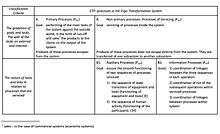
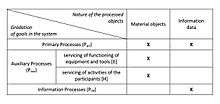
Any ergo-transformational process is the synthesis, the integration of three components, running parallel and mutually coupled sequences – sub-processes involved. They are:
- the sequence of the state transitions of material [M],
- the sequence of human activities directly involved in the process (or the people directly involved in the process) [H],
- the sequence of state transitions of equipment and tools (functioning of equipment and tools) [E].
This law deserves to be called the first basic law of organization and management. Consistently arise from it further logical regularity.
Process classification of the ergo-transformational system depending on gradation of intentional goals and on relationships resulting from servicing, shows Table 2. Are distinguished the following types of processes:
- A) the Primary Processes (Ppri),
- B1) the Auxiliary Processes (Paux),
- B2) the Information Processes (Pinf).
Due to the nature of the processed objects can be distinguished processes for matter processing, and a processes for information data processing (see Table 3).
Law of the servicing by the Auxiliary Processes Paux
The functioning of any ergo-transformational process requires servicing the sequence of human activities 'H' and the sequence of functioning of equipment and tools 'E', by the Paux processes. One may to distinguish four categories of Paux processes:
- The processes of repairs and maintenance of equipment (Prep)
- The processes of servicing of tools (Pt)
- The processes of energy service (Pen)
- The processes of servicing of people (PH)
As belonging to one of the categories of ergo-transformational processes, each Paux process also requires servicing by other auxiliary processes, unless did it himself.
Law of the servicing by the Information Processes Pinf
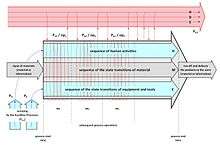
Functioning of any ergo-transformational process is dependent on the integration of its three sequences through servicing by the Pinf processes. Segmentation of ergo-transformational process for consecutive operations also requires servicing by the binding Pinf processes. Therefore, any ergo-transformational process requires servicing by three kinds of Pinf:
- Pinf processes binding three sequences of ergo-transformational process within individual operations
- Pinf processes binding subsequent operations within ergo-transformational process
- Pinf processes binding processes of the ergo-transformational system
Any Pinf process as a special category of ergo-transformational process, also requires servicing by other Pinf process (and of course, by other Paux processes), unless did it himself. Figure 1 presents a logical model of the ergo-transformational process.
Law of multi-dimensional decomposition and synthesis of ergo-transformational systems
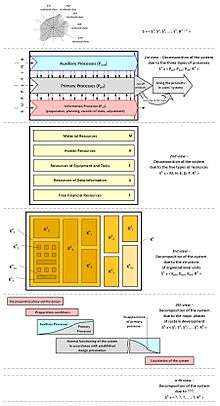
Law of multi-dimensional decomposition and synthesis of ergo-transformational systems can be define as the second basic law of organization and management. The primary issue of identification or designing each ergo-transformational system (new or improved) is their accurate decomposition into subsystems. Arbitrary decomposition into subsystems is methodologically unacceptable, as not based on precise criteria.
ATOM not treat the system as a 'flat' configuration, but as a 'spatial', taken from several points of view - as separate, although reciprocally incorporated 'sectional views' (reflections), depending on separable criteria of decomposition. It is assumed that these cuts may be many, but so far succeeded established only four criteria (sectional views and structures):
- The first sectional view considers the system as the structure of all processes occurring in system: S1 = ⟨Ppri; Paux; Pinf; R1⟩.
- The second sectional view refers to the structure of all the resources participating in the system (materials and products [M], people [H], equipment and tools [E], information resources [D], capital and financial resources (free financial resources) [F] ): S2 = ⟨M; H; E; D; F; R2⟩.
- The third sectional view reflects the hierarchical structure of all organizational units (primary, auxiliary and informational) that make up the ergo-transformational system: S3 = ⟨Kpri; Kaux; Kinf; R3⟩.
- The fourth sectional view presents the dynamics of subsequent stages of the development of the system - from the design of the facility and preparing the way through the stage of implementation and normal operation until the changes or possible liquidation of the system: S4 = ⟨S1; S2; S3; R4⟩.
The individual sectional views belong to the relational configuration of the system: Sn = ⟨S1; S2; S3; S4; ... ; R1...n⟩. Figure 2 cites the schema of system model.
Law of phasic structure of integral Information Process
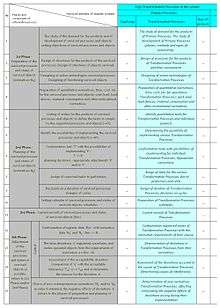
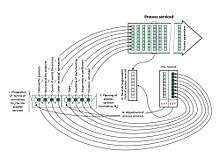
Law of phasic structure of entire Information Process can be described as the third basic law of organization and management. It is a prelude to determine the further regularity of designing of the information subsystems.
The essence of any Information Processes (Pinf) is servicing of other processes or objects. In any integral Pinf process there are four consecutive phases:
- Phase of prospective preparation products parameters serviced processes, the methods of achieving and other factors (normative N1),
- Phase of the planning serviced processes (Np),
- Phase of current state records and results of running serviced processes, once operational (Rec),
- Phase of the control and adjustment serviced processes.
A more detailed interpretation of the successive phases of any Pinf process, presents Table 4. Figure 3 shows the relationships between the phases of the Information Process and parameters of serviced processes.
Regularity of the links between processes. Models of relationships.

These regularity and the models are a consequence resulting from the previously specified laws, i. e.: the law of the process structure (three related sequences of changes), the law of unavoidable servicing of two sequences by a specialized Auxiliary Processes (Paux) and the law of the sequence servicing by the relevant Information Processes (Pinf). There can be many variants of the possible combinations of servicing of processes and coupling of processes. In any case, always spaces the law of servicing of everyone without exception ergo-transformational processes. Figure 4 presents an example model of linkages and couplings between the serviced and servicing processes of the ergo-transformational system.
Regularity of combinatorics any kind of processes in any ergo-transformational system
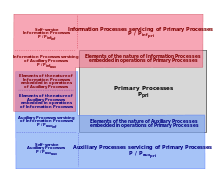
In any ergo-transformational system it is unavoidable occurrence of a set of Primary Processes (Ppri), Auxiliary Processes (Paux) and Information Processes (Pinf). Depending on the nature of the processed materials is grouped processes for matter processing, and a processes for information processing. Figure 5 refers to the mutual relationships between Primary Processes (Ppri), Auxiliary Processes (Paux) and Information Processes (Pinf) in ergo-transformational system.
Management as a special kind of Information Process
The regularity of the above shows that the management can only logically be interpreted as a Pinf process higher degree. This process coordinates a several Pinf processes on lower degree. Particularly relevant to management processes is its integrity; they must take into account comprehensive the requirements for control of all Primary Processes (Ppri), Auxiliary Processes (Paux) and Information Processes (Pinf) and cover all four phases and components of Information Process.
According to gradation of linkages and coupling of ergo-transformational processes, process of management is a Pinf process at least 3rd degree (Pinf ≥ 3), co-ordinating Information Processes at least 2nd degree (Pinf ≥ 2). Information Processes lower degree (Pinf ≤ 2) can be oriented to either phase or part of an integrated Information Process, or to control of one kind of the process in ergo-transformational system.
It follows, that the term 'organization' in the sense of functional can be interpreted as each Information Processes of at all levels in ergo-transformational system. For example, a worker at the workplace, master, technologist, engineer, clerk, planner, controller, etc., certainly are involved in the organization, but do not always have to be a 'management', which is the domain of information processes of higher degrees, usually associated with higher levels of management.
References
- Chajtman, S. (1995). "Krytyka i zmiana paradygmatów w naukach o organizacji i zarzadzaniu" [Criticism and the paradigms shift in the science of organizing and managing]. Organizacja i Kierowanie (in Polish). Warsaw: The Committee of Organization and Management Sciences, Polish Academy of Sciences. 4. ISSN 0137-5466.
- This assertion replace widespread view that the purpose of organization and management is a 'work process' or any other views on this topic.
Bibliography
- Chajtman, S.; Zyzik, M. (1984). "Some Theoretical Problems of the Factory of the Future". Proceedings of the Conference on Factory of the Future. Tel Aviv.
- ——; Zyzik, M. (1985). "The Identification of Information Processes in the Manufacturing". Proceedings of the 8th International Conference on Production Research. Stuttgart.
- —— (1986). Systemy i procesy informacyjne [Information systems and processes] (in Polish). Warsaw: Panstwowe Wydawnictwo Ekonomiczne PWE. ISBN 83-208-0521-X.
- ——; Borzęcki, J. (1987). Методические проблемы моделирования системы управления как основа их автоматизации и применения ЭВМ [Methodological problems of modeling management system as the basis for its automation and the use of computers]. COMPCONTROL Conference (in Russian). Moscow.
- ——; Zyzik, M. (1987). "Modelling Relations Between Processes in the Production System". Proceedings of the 9th International Conference on Production Research. Cincinnati, Ohio, USA.
- ——; Borzęcki, J. (1988). "Metodyczne podstawy analizy i projektowania struktury aparatu zarządzania przedsiębiorstwa na tle wieloprzekrojowej dekompozycji systemu gospodarczo-produkcyjnego" [Methodological basis for the analysis and design of business management structure on a background multiple cross-sectional decomposition of the economic system]. Zeszyty Naukowe Politechniki Poznańskiej (in Polish). Poznan. No. 14.
- ——; Borzęcki, J. (1989). Выделение информационной системы в хозяйственной единице как основа комплексного проектирования информатических систем [Extracting information system of an enterprise as a basis for the design of complex IT systems]. COMPCONTROL Conference (in Russian). Bratislava.
- —— (2002). "Alternatywne poglądy nieodzownym warunkiem przekształcenia wiedzy o organizacji i zarządzaniu w uogólnioną teorię i akceptowaną naukę" [Alternative views indispensable condition for the transformation of knowledge about the organization and management theory in the generalized and accepted science]. In Krupski, R.; Lichtarski, J. (eds.). Stan i perspektywy rozwoju teorii i praktyki zarządzania na progu XXI wieku [Status and prospects of development of the theory and practice of management on the threshold of the twenty-first century] (in Polish). Wroclaw: Wydawnictwa Akademii Ekonomicznej we Wrocławiu.